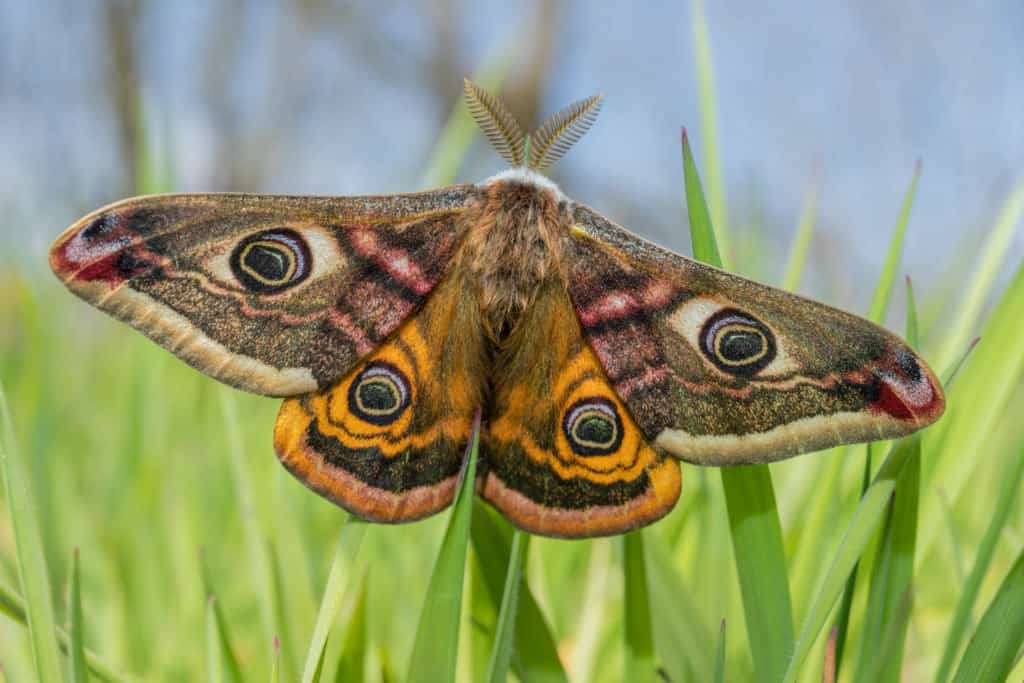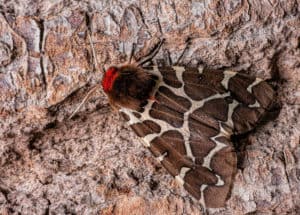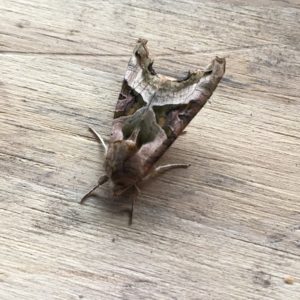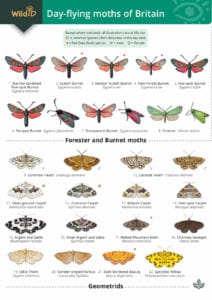By Rachel Davies, BioLinks West Midlands Project Officer
Moths are a diverse, fascinating group of insects. They play an important ecological role as they pollinate plants and provide a food source for birds, bats and other wildlife. Due to the fact that many species fly at night, they are often overlooked, as many recorders are already tucked up in bed before they are on the wing. However, there are a small number of day-flying moths in the UK, perfectly suited to biological recorders that like to go out and find species on warm, sunny days.

Day-flying Moth Species in the UK
There are approximately 2,500 species of moth in the UK. The majority of these fly at night, and unless actively recording with different surveying methods, many people will only ever come across a few species. There are a handful of moths that are classed as day-flying moths. These are moths that are active during the day and tend to fly when it is warm and sunny- similar to butterflies. Many of them are also brightly coloured like their close relatives, and without knowing some subtle differences, they may be mistaken for butterflies.

Butterflies and moths can be distinguished through a combination of observations. Firstly, moths tend to always rest with their wings flat, whereas butterflies typically rest with their wings together. Moths also tend to rest with their antennae tucked down or folded back, whereas butterflies tend to hold theirs upwards. Lastly, butterflies have a thickened end to their antennae, giving them a slightly clubbed appearance. Moths do not have clubbed antennae.
Approximately 130 species of macro-moths in the UK are classed as day-flying, and they include groups such as the foresters, tigers and burnets. There are also a handful of micro-moths that are classed as day-flying too, although these tend to be more challenging to identify.
Surveying Techniques
Typically, when surveying for moths we use a light trap. However, this is not suitable for day-flying moths as they are not attracted to light. Instead, day-flying moths can be surveyed in a similar way to butterflies – you can walk around the survey area checking flowers and either tapping vegetation to dislodge individuals or sweep netting to capture them. Some moths will show a preference for certain species of flowers, so these can be targeted if you are searching for a particular species. Warm, dry days make for favourable survey conditions.

Pheromone lures can also be used for certain species of day-flying moths with high success rates. Lures work by copying the pheromones released by female moths – literally luring the males in. They are a helpful technique for some day-flying species that are harder to locate. However, they should not be used frequently, and placement must be considered to avoid spider webs or other hazards. Species such as the emperor and clear-wings can be surveyed in this way.
Many of our night-flying moths will roost during the day, and so it is possible that you will come across them whilst searching for day-flying moths. Roosting areas include tree trunks, fence posts, tufts of grass and other sturdy structures. As the day warms up, these individuals will move away from warmth and sunlight, so if you wish to see them, searching early morning is best.
Day-flying Moths to see in June
With warmer weather and longer days, June is a fantastic time to go out and spot some of our day-flying moths. Here are a few species you may see this month.
The cinnabar moth, Tyria jacobaeae, is a brightly coloured day-flying species that can be found in abundance resting in grassy areas. You can spot the caterpillars easily if you start to look at ragwort plants, as this is what they feed on, and they are bright orange with black stripes.
The latticed heath moth, Chiasmia clathrata, is a splendid-looking moth with a brown lattice grid pattern on the upperside and underside of its wings. This species is often mistaken for a butterfly as it tends to bask with its wings open and often rests with its wings held together.
The yellow shell moth, Camptogramma bilineata, is a medium-sized moth that can often be close to the ground around the bases of hedges and fences. This species offers in many different habitats and has several different colour forms.
The silver y moth, Autographa gamma, is one of the most commonly seen day-flying moths. This species has a clearly visible, distinctive ‘Y’ mark on its wing, which aids identification.
The scarlet tiger moth, Callimorpha dominula, is a large species with a distinctive wing pattern. This attractive moth mainly inhabits marshy grassland, river banks and sand dunes, but it can also pop up in gardens and other suburban areas.
Identification Resources
WILD Guides have produced a fantastic field guide titled ‘Britain’s Day-flying Moths- A field guide to the day-flying moths of Britain and Ireland’ by Newland, Still and Swash. The Field Studies Council have also produced a fold-out guide to day-flying moths, which depicts 103 different species.
If you are also interested in looking for roosting moths, a copy of ‘Field Guide to the Moths of Great Britain and Ireland’, by Warring and Townsend would be a useful aid. There is also a micro moth accompaniment text titled ‘Field Guide to the Micro Moths of Great Britain and Ireland’, by Sterling and Parsons.
If you do not wish to invest in field guides at this stage, Butterfly Conservation have a fantastic online moth identification tool, plus some other useful resources, including a day-flying moth print-out guide.
Submitting Records
Submitting records is an essential part of surveying as the data that is created can be used to inform conservation projects and decisions. Recording is easy once you know how, and there are several ways in which you can record day-flying moths:
iRecord
iRecord is a free tool created by the Biological Record Centre to support naturalists and biological recording schemes and societies. It facilitates the submission of biological records into the complicated network of organisations that make up the UK’s biological recording community.
On iRecord, there is a specific ‘species group form’ for submitting moth records.
If you would like to learn how to use iRecord we have an online course exploring the platform in 2023.
Big Butterfly Count
This short citizen-science survey was originally mainly focused on butterflies, but it does include records for some day-flying moths too. More information can be found here.
National Moth Recording Scheme
This scheme accepts records of all moth species in the UK. Records can be submitted directly to County Moth Recorders, and you can find your County Moth Recorder here. Records submitted to County Moth Recorders can be sent over by email, and each recorder will have a preferred method of receiving records (such as in an Excel spreadsheet).
The National Moth Recording Scheme (NMRS) also has a new way to record your sightings to the scheme through their online portal. This online portal links up with iRecord (and can link up to any existing iRecord account), allowing records to be viewed by the scheme and iRecord. Sign up to the NMRS Online portal here.
When submitting records, through whichever method you choose, don’t forget to include the ‘Who, What, When, Where’.
• ‘Who’ is the recorder
• ‘What’ is the species seen
• ‘When’ is the date it was seen
• ‘Where’ is the location.
You can also include further information, such as the survey method, but the four W’s are the most important parts of any record.
If you would like to learn more about moths or butterflies, take a look at our courses or publications.






